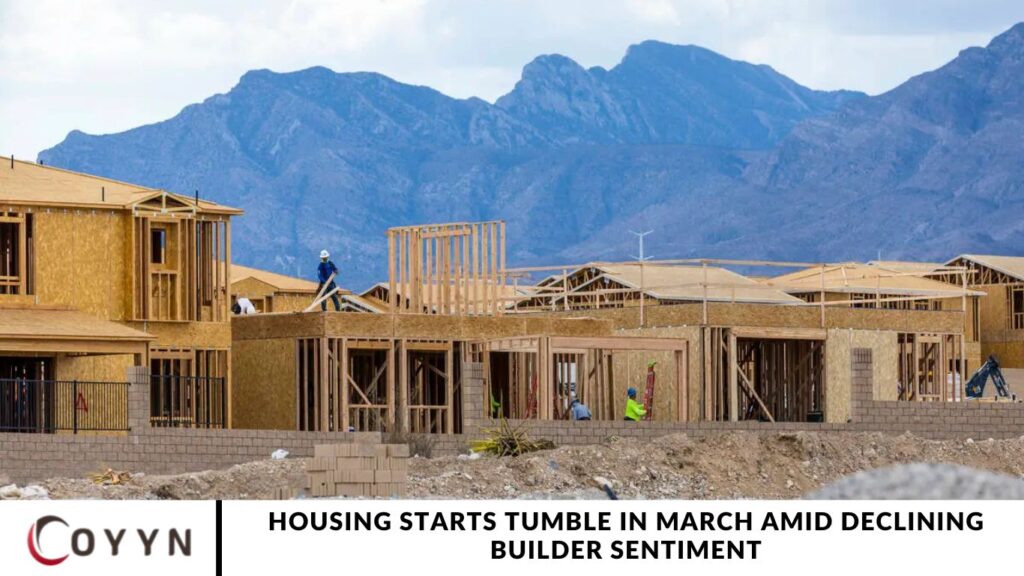U.S. housing starts, a key indicator of residential construction and a significant component of GDP dropped sharply in March—signaling potential weakness in first-quarter economic growth.
New home construction fell 11.4% month-over-month, landing at an annualized rate of 1.3 million units—well below the level needed to meet long-term housing supply and demand.
Meanwhile, housing completions declined for the second consecutive month, dipping 2.1% in March. This trend aligns with increasingly negative builder sentiment, raising concerns about near-term momentum in the real estate sector.

With housing supply expected to remain constrained in the coming months, relief from rising home prices seems unlikely. Elevated prices have been a key factor in pushing inflation higher, keeping pressure on buyers and the economy as a whole.
Building permits, a leading indicator for future housing starts, showed a slight improvement, rising 1.6% in March after three consecutive months of decline. While this uptick offers a glimmer of hope, it may not be enough to offset the ongoing supply challenges.
The ongoing uncertainty around trade policy is another significant factor impacting the construction industry. Building materials, which are particularly vulnerable to higher tariffs, are seeing unpredictable price fluctuations that make it difficult for builders to plan effectively.
This lack of clarity about material costs, coupled with the secondary effects on demand, has led many builders to take a more cautious approach, staying on the sidelines rather than committing to new projects.
If economic volatility persists, homebuilders’ year ahead will likely be slow, and overall housing market activity will continue to slump.
Frequently Asked Question
What caused the decline in housing starts in March?
The 11.4% drop in housing started in March and was driven by weakening builder sentiment and ongoing economic uncertainty, including higher tariffs on building materials and fluctuating material costs.
What does the decrease in housing starts mean for the economy?
The decline signals a potential slowdown in residential construction, which could negatively impact economic growth in the first quarter of the year, as housing starts are an essential component of GDP.
How does builder sentiment affect housing starts?
Builder sentiment reflects builders’ confidence in the market. When confidence drops, builders may delay or scale back projects, contributing to a decline in housing starts.
What are housing starts?
Housing starts refer to the number of new residential construction projects that begin within a given period. This is a key indicator of economic health and the housing market.
Are housing prices likely to drop soon?
Due to tight housing supply and ongoing builder uncertainty, it’s unlikely that home prices will see significant relief in the short term. Elevated prices are expected to keep inflation high.
What is the relationship between building permits and housing starts?
Building permits serve as a leading indicator for future housing starts. A rise in building permits can signal that more homes may be built in the coming months, although the recent 1.6% increase is modest after previous declines.
How does trade policy uncertainty affect the housing market?
Trade policies, especially higher tariffs on building materials, create price volatility, which complicates construction planning and leads to builders’ hesitation, slowing down new projects.
Conclusion
The sharp decline in housing starts in March, coupled with the drop in builder sentiment, signals a challenging outlook for the residential construction sector in the near term. With material costs influenced by volatile trade policies and a tight housing supply, builders are understandably cautious, which may further constrain the housing market. As home prices remain elevated and inflation continues to pressure the economy, the slowdown in construction will likely persist throughout the year. If economic uncertainty persists, we can expect a slow year for homebuilders and continued strain on the broader housing market. Policymakers and industry leaders will need to address these issues to provide relief and support long-term stability in the housing sector.


